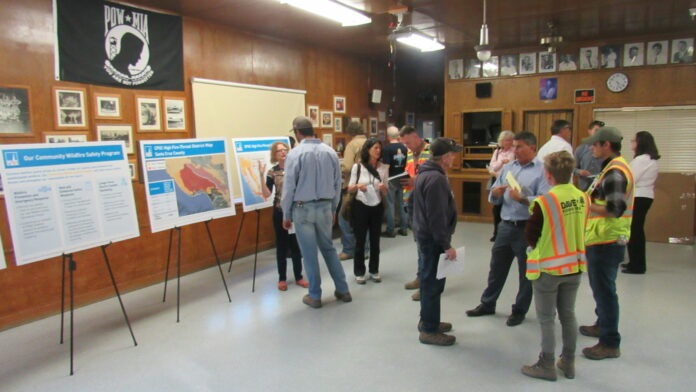With a slew of questions from the community, PG&E came up short with answers after a disorganized public outreach meeting that was planned at a day’s notice. The public meeting was held Wednesday afternoon at the Ben Lomond Fire Department, but the session turned somewhat rancorous after it became clear that no new, locally-oriented information about PG&E’s tree cutting for the Community Wildfire Safety Program was going to be available.
The meeting was conducted in a “drop-in/open house” format where PG&E representatives were available for one-on-one conversations with local residents, in front of a series of PG&E poster boards describing the need for and dimensions of the tree cutting currently going on throughout the San Lorenzo Valley for wildfire safety.
When it became clear the meeting was not going to include a “town hall format,” where residents could ask direct questions of PG&E representatives, one-at-time, and be able to hear the answers above the din of the “open house” conversations, the mood of many participants turned sour and critical.
“This is a farce,” said Karen Ehrlich of Lompico. “They don’t have answers to three-quarters of our questions, and it’s so disorganized with no single spokesperson from PG&E- this is not a town hall meeting we were expecting, it’s just a propaganda meeting where it obvious they have done nothing to address our issues.”
About half-way through the scheduled time of the meeting, Lorraine Palmer, resident of Boulder Creek, stood up on a chair and tried to persuade about 20 or 30 attendees that it would be more productive for everyone to line up and ask questions one at time, like a town hall meeting, and PG&E representatives could answer.
“That’s not what we’re going to,” said Rob Morse, PG&E’s Manager of Local Customer Experience. “This is not set up as a town hall meeting …this is to address concerns one-on-one.”
Morse also indicated to the Press Banner that he and the other PG&E representatives at the meeting were not allowed to discuss PG&E policies with the media, and any questions could only be addressed by PG&E’s media liaison, who was not at the meeting.
“This is a typical PG&E method to diffuse the ability of people to really understand the problem,” said Nancy Macy, chair of the environmental committee of the Valley Women’s Club, who is leading a public campaign to stop, or at least slow down, the tree cutting that PG&E is doing in the mountains.
Macy recalled that a real, town hall-style meeting was effective when PG&E was called to answer for tree cutting along natural gas pipelines last year, and PG&E officials were forced to say in a public meeting, ‘Yes, you as a private property owner can prevent PG&E from cutting down your trees,’” said Macy. “That kind of information is apparently not what they want to share at this meeting,” Macy said.
At least one resident of Boulder Creek, who did not want to be identified, said he was satisfied with the one-on-one format and the conversation he had with a PG&E representative, having to do with the disposing of cut wood and wood chips on his property. “Most homeowners are on-board with the tree trimming,” said a contracted tree serviceman who did not want to be identified by name.
Members of the Valley Women’s Club handed out fliers informing property owners of their right to refuse or negotiate tree removal by PG&E on their property. “If you see an “X” on a tree that means it will be removed. If you see a dot on a tree that means it will be trimmed ground-to-sky, including redwood trees,” reads the handout. “You may also want to put signs on specific trees to let ground crews know which trees you want to protect.”
Mayra Tostada, PG&E spokesperson, wrote in an email to the Press Banner after the meeting, “Nothing is more important than the safety of our customers. We are committed to continue meeting with our customers to answer questions they may have about our important safety vegetation work in high fire-threat areas designated by the CPUC.”
Of particular interest to several members of the Valley Women’s Club in attendance was PG&E’s response to a strongly worded letter, dated Oct. 18, from Fifth District Supervisor Bruce McPherson and state Assemblymember Mark Stone to PG&E’s CEO Geisha Williams and Vice President Gregg Lemler. The letter references “a great deal of confusion and suspicion among our constituents” about tree cutting on private property.
“Setting aside the lack of transparency about the scope of the Wildfire Safety Program, our primary concern relates to the lack of information available about PG&E’s plans to repair and replace its aging infrastructure,” the letter explained. The letter urges PG&E to prioritize the “hardening” and improvement of the power lines themselves rather than focusing on tree removal, which “could prove to be as effective, if not more so, than vegetation management,” according to the letter.
Tostada’s response to the letter after the meeting was, “We have received the letter and are working to answer the important questions raised by Supervisor McPherson and Assemblymember Stone. We want to make sure that we talk to both of them to make sure we’re able to adequately address these important issues,” Tostada wrote in her email.
J.M. Brown, an analyst for Supervisor’s McPherson, said the supervisor’s office has been encouraging PG&E to engage in a traditional, question and answer town hall-style meeting for several weeks, “but PG&E has declined to schedule such a meeting at this time,” Brown said.
PG&E encouraged customers to call (877) 295-4949 for more information about the Community Wildfire Safety Program, or email at wi************@*ge.com.













